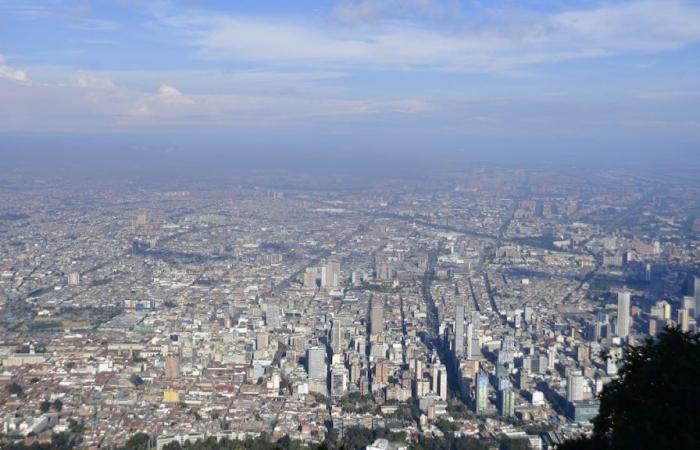Image of the layer of air pollution that is usually seen in Bogotá.
Photo: GUSTAVO TORRIJOS
One of the things that torments me when I go for a walk with Gaia, my pet, in the morning, is looking towards Bogotá. Those of us who walk near the eastern hills always find a thick layer of smog floating over the buildings. I remember that the first time I saw a similar photo in a newspaper, more than a decade ago, there were many people who were alarmed and scared to live in a place like that. Today it has become common to look to the west and see that gray “cloud” for a long time. Also pedal along Carrera Séptima or Caracas Avenue between trails of smoke left by buses and Transmilenios.
No one would want to live in a city with high levels of polluted air. But it is not always easy to know precisely if the air in which we usually move is a risk to our health. We sense that it is not okay to breathe it, but measuring what it implies is not so simple.
If we want to summarize it in a single figure, the one revealed by the Pollution and Health series, from the magazine The Lancetin 2022, may be useful: there are 6.67 million deaths that every year are attributed to air pollution. It is a number similar to the deaths that are caused by cigarettes (7 million). Or, to put it in other terms, that is almost three times the number of people who live in Medellín.
What we can know is At what points is it not such a good idea to breathe air? and in which ones we can walk more calmly. That is what the new report presented by Ideam on June 25 shows, without many cameras or many reflectors. As Simón Grueso Casquete, one of the people who participated in its preparation, said, it is a photograph that they are giving to the country so that it knows where the air is being monitored and what its quality is.
He Report on the status of air quality in Colombia 2022, As they titled it, it has various data that helps us understand what we are breathing. The first thing to say before exploring them is that among all the pollutants in the air, such as sulfur dioxide, ozone or carbon monoxide, Ideam focused on so-called “particulate matter”, which is usually synthesized with the acronym PM. . On the one hand, because other pollutants do not usually reach worrying levels in cities, and, on the other, because there is very robust research that links PM with lung and cardiovascular diseases.
Those who have studied the PM divide it into two broad categories. One refers to the largest particles, which have a diameter of 10 microns (μg) or less (called PM10). The other is made up of tiny particles with a diameter of 2.5 microns that can cross the barrier of the lungs and enter the blood and other organs. They call them PM2.5. To get an idea, just remember that a human hair can measure about 20 times more than a PM2.5 particle.
That said, in the Ideam report There is good news and other worrying news. In the good news, we must mention that 41% of the stations in the country and whose data were included in the study, adjusted to the guide value suggested by the World Health Organization (WHO) (15 μg/m3). Data from another 42% met the maximum PM10 level allowed annually (50 μg/m3). Only a small fraction (3%) exceeds 50 μg/m3. There are also stations that show a tendency to adjust to the maximum limit: two are in Medellín (at Éxito San Antonio and Tráfico Centro) and another in Soacha, Cundinamarca (at Colegio Soacha).
However, when talking about PM10 There are stations that are measuring air, whose quality seems to worsen over the years: that of SENA (in Sogamoso), that of Kennedy, Ciudad Bolívar and Tunal (in Bogotá) and that of Tráfico sur (in Sabaneta). Besides, there are 2 seasons where the air quality lasted between 30 and 56 days above what is allowed: Móvil Fontibón with 56 days, and Colegio Soacha, with 36 days. Both are in Soacha, Cundinamarca.
But the not so good news is in the analysis of PM2.5 particles, the ones that most often worry those who work in the world of health. Although 94.1% met the maximum permissible level per year (25 μg/m3), there are several points in Colombia that are worrying.
As the following map shows, There are 7 stations where there has been an increase in recent years. These points are Mochuelo (Bogotá), Tráfico sur (Sabaneta), Tráfico central (Medellín), Fiscalía sector Caribe (Medellín), ITA-LGO (Medellín), Casa Justicia (Itagüí) and Colegio Soacha (Soacha).
Another worrying thing is that compared to the previous year, At no station where PM2.5 particles are measured was there a downward trend. “The areas where the stations are located that show a tendency to increase the concentrations of this pollutant require priority attention from environmental authorities,” ask the authors of the report.
In fact, they recall that 47 stations recorded levels higher than the maximum daily permissible level (37 μg/m3), which corresponds to 55.9% of the total stations. As if that were not enough, there were 41 stations where the norm was exceeded for less than 16 days; 5 more in which the limits were exceeded for 20 and 32 days; and one in which 57 days were reported in which the allowed limit per day was exceeded. It was the Mochuelo station, in Ciudad Bolívar, in Bogotá.
There is groups that may be especially affected by breathing these types of particles. Among them, children, older adults or pregnant mothers. “The fetus is especially vulnerable to the mother’s exposure to contaminants that cause latent risks to the baby,” Ideam recalls in a section.
“In children, this could mean reduced lung growth and function, respiratory infections and worsening asthma. In adults, ischemic heart disease and stroke are the most common causes of premature death attributable to outdoor air pollution,” reads the WHO website.
The Ideam team also detailed in the document how several cities in the country are doing, such as Medellín or Manizales, or regions where there may be contamination from mining exploitation, such as Cesar. After doing so, one of its major conclusions is that, when reviewing “the weighting of the air quality index (AQI), it was observed that categories harmful to the health of sensitive groups and harmful to health were reached, in a higher proportion in contrast with the monitored gases. This underlines the imperative need to join forces to reduce these concentrations and improve air quality.”
There is another urgent need that the country has, and which was recalled in the presentation of the study by the professor with a master’s degree in Public Health from the U. de los Andes, Luis Jorge Hernández, who has been doing research on air pollution for several years: we must increase the coverage of stations to measure air quality in the country.
213 stations were included in the study, which are in only 88 municipalities in 20 departments. The majority are in Antioquia (there are 59), Bogotá (20) and Cundinamarca (20). There are none in the Amazon and Orinoquia, which are usually affected by constant and enormous fires.






